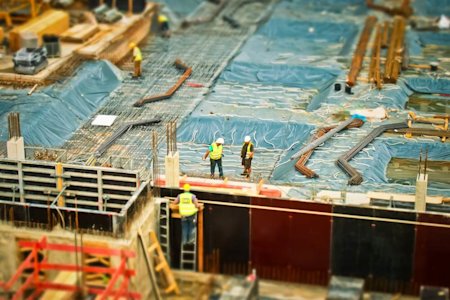La réalité augmentée transforme divers secteurs d’activité en superposant des informations numériques au monde réel, améliorant ainsi la perception et les interactions de l’utilisateur avec son environnement.
Dans le secteur du bâtiment, la réalité augmentée devient un outil pivot, offrant des solutions innovantes à des défis complexes. De la planification et de la conception de projets aux inspections sur site et à la téléassistance, la réalité augmentée remodèle la façon dont les projets BTP sont exécutés.
Ce article explore l’importance de la réalité augmentée dans le secteur du bâtiment et ses applications.
Qu’est-ce que la réalité augmentée pour le bâtiment ?
La réalité augmentée (RA) est une technologie qui améliore le monde réel en superposant des informations numériques, telles que des images, des vidéos et des sons, à l’environnement physique. Contrairement à la réalité virtuelle (RV), qui crée une expérience virtuelle complètement immersive, la RA intègre des éléments numériques dans le monde réel, offrant une expérience interactive et enrichie.
À l’aide d’appareils tels que des smartphones, des tablettes ou des lunettes de RA, les utilisateurs peuvent visualiser et interagir avec du contenu numérique superposé à leur environnement réel. Cette intégration permet une application plus attrayante et pratique dans divers domaines, notamment les jeux, l’éducation, les soins de santé et, notamment, le secteur du bâtiment.
Dans le secteur du bâtiment, la RA peut être utilisée pour une gamme d’applications, de la visualisation des concepts de bâtiments à la réalisation de visites virtuelles en passant par la téléassistance. En fournissant des données et des visualisations en temps réel, la RA aide les professionnels du BTP à prendre des décisions plus éclairées, à renforcer la précision et à améliorer l’efficacité globale du projet.
Quelle est la différence entre la RA et la RV ?
La RA superpose des éléments numériques au monde réel, améliorant l’environnement de l’utilisateur grâce à des appareils tels que les smartphones ou les lunettes de RA. La RV, quant à elle, crée un environnement virtuel entièrement immersif, isolant l’utilisateur du monde physique. Alors que la RA permet d’interagir avec des éléments numériques et du monde réel, la RV offre une expérience entièrement simulée, nécessitant souvent des casques spécialisés. La RA améliore la réalité sans la remplacer, tandis que la RV remplace la réalité par une expérience virtuelle.
Obtenez plus d’informations sur la différence entre RA et RV.
Principales applications de la réalité augmentée dans le secteur du bâtiment
La RA offre de nombreuses applications pour le secteur du bâtiment, transformant les pratiques classiques et améliorant l’efficacité. Voici quelques applications clés :
Visualisation de la conception : la RA permet aux parties prenantes de visualiser des modèles 3D de bâtiments sur site, offrant une vue réaliste de la structure finale. Cela permet de mieux comprendre la conception et d’améliorer la prise de décision.
Gestion de projet sur site : grâce à la RA, les chefs de projet peuvent superposer des informations numériques sur le site physique, identifier les problèmes potentiels et vérifier que le bâtiment correspond aux plans.
Formation et sécurité : la RA offre des expériences de formation immersives aux travailleurs, simulant des scénarios du monde réel pour améliorer les compétences et la sensibilisation à la sécurité.
Assistance à distance : les techniciens peuvent utiliser la RA pour fournir des conseils à distance, en superposant des instructions à la vue du travailleur, réduisant ainsi les temps d’arrêt et les coûts de déplacement.
Maintenance et réparations : la RA permet aux techniciens de visualiser des éléments cachés tels que le câblage et la plomberie, rationalisant ainsi les tâches de maintenance et de réparation.
L’impact de ces applications est considérable, conduisant à une précision accrue, à une réduction des erreurs, à une collaboration renforcée et à une amélioration globale des résultats du projet. La RA dans le secteur du bâtiment améliore non seulement l’efficacité, mais facilite également l’innovation, ce qui en fait un outil indispensable sur le marché moderne.
Les avantages de la réalité augmentée dans le bâtiment
La RA transforme le secteur du bâtiment en améliorant l’efficacité, la précision et la collaboration. Voici certains des principaux avantages :
Précision améliorée et réduction des erreurs : la réalité augmentée permet aux équipes de comparer les plans numériques avec les progrès réalisés sur site, afin de réduire les erreurs et les retouches coûteuses.
Prise de décisions plus rapide : la collaboration en réalité augmentée en temps réel permet aux équipes à distance d’évaluer les problèmes et de prendre des décisions éclairées sans se rendre sur site.
Sécurité accrue des travailleurs : des formations et des simulations de sécurité basées sur la réalité augmentée aident les travailleurs à identifier les dangers et à suivre les protocoles de sécurité de manière plus efficace.
Maintenance et réparations simplifiées : les diagnostics assistés par la réalité augmentée permettent aux techniciens de visualiser les composants cachés, ce qui rend les tâches de maintenance plus rapides et plus précises.
En intégrant la RA dans les workflows de construction, les entreprises peuvent accroître la productivité, réduire les coûts et améliorer les résultats globaux des projets.
Défis de la mise en œuvre de la RA dans le secteur du bâtiment
La mise en œuvre de la RA dans le secteur du bâtiment s’accompagne de plusieurs défis :
Adoption de nouvelles technologies : l’intégration de la RA nécessite un changement par rapport aux méthodes classiques, qui peut se heurter à la résistance des parties prenantes qui ne connaissent pas la technologie.
Courbe d’apprentissage : les travailleurs et les responsables doivent être formés à l’utilisation efficace des outils de RA, ce qui peut prendre du temps et nécessiter des ressources supplémentaires.
Coût : l’investissement initial dans les équipements et les logiciels de RA peut être important, ce qui peut dissuader l’entreprise d’adopter la technologie.
Solutions logicielles robustes : une mise en œuvre réussie nécessite un logiciel fiable et sophistiqué capable de gérer des données complexes et des opérations spécifiques aux projets de construction.
Intégration avec les systèmes existants : s’assurer que la technologie RA s’intègre de manière parfaite aux processus et systèmes de construction actuels peut être difficile et nécessiter des solutions personnalisées.
Malgré ces défis, les avantages de la RA en termes d’amélioration de l’efficacité, de la précision et de la collaboration en font un investissement rentable pour les entreprises BTP à la pointe du secteur.
Importance croissante de la téléassistance dans le secteur du bâtiment
La téléassistance devient de plus en plus vitale dans le secteur du bâtiment, motivée par le besoin d’efficacité, de réduction des coûts et de collaboration renforcée. Voici quelques cas d’utilisation clés :
Assistance technique : les experts peuvent guider à distance les travailleurs sur site à travers des tâches complexes, réduisant ainsi le besoin de présence physique et minimisant les temps d’arrêt.
Dépannage et maintenance : les techniciens peuvent diagnostiquer et résoudre les problèmes d’équipement à distance, ce qui garantit des solutions rapides et évite les retards de projet.
Formation et développement des compétences : la téléassistance basée sur la RA permet d’offrir des sessions de formation immersives, aidant les télétravailleurs à acquérir de nouvelles compétences sans avoir recours à des formateurs sur place.
Collaboration et communication : les outils de réalité augmentée facilitent la collaboration en temps réel entre les experts hors site et les équipes sur site, améliorant ainsi la prise de décision et la coordination des projets.
L’adoption de solutions de téléassistance dans le secteur du bâtiment améliore la productivité, réduit les coûts de déplacement et garantit que l’expertise est disponible au moment et en l’endroit où elle est nécessaire.
Compléter la téléassistance par Splashtop AR
Splashtop AR apporte une solution efficace pour le secteur du bâtiment en améliorant les capacités de téléassistance grâce à la réalité augmentée. Voici comment :
Annotations interactives : les techniciens peuvent utiliser la RA pour dessiner et placer des marqueurs directement sur le flux vidéo en direct, guidant les travailleurs sur site avec des instructions précises. Cette fonctionnalité est inestimable pour le dépannage et fournit des conseils étape par étape.
Partage de caméra : les travailleurs sur le terrain peuvent partager le flux de leur caméra en temps réel avec des experts à distance, ce qui permet une évaluation visuelle et une assistance instantanées. Cette capacité permet de diagnostiquer rapidement les problèmes et de fournir des solutions en temps opportun.
Communication VoIP : la communication vocale intégrée permet aux travailleurs sur site et aux experts à distance de discuter et de résoudre les problèmes sans avoir besoin d’outils de communication distincts. Cette interaction parfaite accélère la résolution des problèmes et réduit les erreurs de communication.
Contrôle à distance de la lampe de poche : les experts peuvent contrôler à distance la lampe de poche sur l’appareil du travailleur sur site, assurant une meilleure visibilité dans des conditions de faible luminosité. Cette fonction est particulièrement utile pour inspecter les zones qui ne sont pas bien éclairées.
Enregistrement des sessions : les sessions peuvent être enregistrées à des fins de formation, d’assurance qualité et de documentation. Cette fonctionnalité permet de tenir des registres de l’assistance fournie et peut être utilisée pour former les nouveaux employés.
Splashtop AR permet aux entreprises BTP de surmonter les barrières géographiques, de réduire le besoin de déplacements sur site et d’améliorer l’efficacité de la téléassistance. En intégrant la RA dans leurs flux de travail d’assistance, les entreprises du BTP peuvent garantir une résolution plus rapide des problèmes, une meilleure formation de leur personnel et une productivité globale améliorée.
Premiers pas avec Splashtop AR
Splashtop AR révolutionne la téléassistance dans le secteur du bâtiment en intégrant des fonctionnalités avancées de réalité augmentée. Pour profiter des avantages d’une assistance à distance améliorée, d’une communication simplifiée et d’une résolution efficace des problèmes, envisagez de mettre en œuvre Splashtop AR dans vos projets.
Que vous ayez besoin de fournir des instructions détaillées, d’effectuer des inspections à distance ou d’animer une formation sur site, Splashtop AR offre les outils dont vous avez besoin pour réussir. Découvrez l’avenir de l’assistance à la construction en obtenant plus d’informations sur la façon dont Splashtop AR peut transformer vos opérations.





